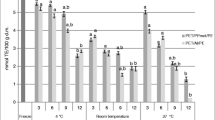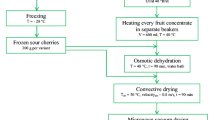Abstract
Sour cherry (Prunus cerasus L.) contains substantial quantities of phenolic compounds, specifically anthocyanins, and is mainly processed into different products including juice, whose by-product, namely sour cherry pomace (SCP), represents a potential source of high added bioactive compounds currently underutilized. Oven drying and freeze drying (FD) are simple methods, often used to stabilize food matrices, and can be also successfully employed for the stabilization of sour cherry pomace. In the present study, the influence of genotype (Bianchi d’Offagna and Montmorency cvs), drying method and their interaction on the extractability of phenolic and anthocyanin profiles of sour cherry pomace were evaluated. Both genotype and drying method significantly influenced (p ≤ 0.001) the overall phytochemical content (total monomeric anthocyanin, total flavan-3-ol, total phenolic, and vitamin C) of the analyzed pomaces. The interrelationships between the parameters analyzed, the genotype, and the different drying conditions, as well as the relationships among variables, were investigated by principal component analysis (PCA). PCA results pointed out that the phytochemical content of sour cherry pomace was firstly influenced by the cultivar (which accounted for about 70% of the total variance), followed by the drying process (about 18% of the total variance), and their interaction (about 12% of the total variance), with the exception of total flavan-3-ols, where a similar contribution (about 50%) of the two factors was observed. Besides, the antidiabetic potential of SCPs was also investigated, showing Bianchi D’Offagna FD pomace to be the most active. The obtained results point out that the SCP stabilized by means of the freeze-drying process is a valuable second-generation biorefinery for food supplements and nutraceutical and pharmaceutical markets.


Similar content being viewed by others
References
Germano G, Hoes A, Karadeniz S, Mezzani A, Prescott E, Ryden L, Vrints C (2012) European Guidelines on cardiovascular disease prevention in clinical practice. Eur Heart J 33:1635–1701
Annunziata A, Vecchio R (2011) Functional foods development in the European market: a consumer perspective. J Funct Foods 3:223–228
Food and Agriculture Organization of the United Nations, 2014; http://faostat.fao.org. Accessed 10 Aug 2016
Burkhardt S, Tan DX, Manchester LC, Hardeland R, Reiter RJ (2001) Detection and quantification of the antioxidant melatonin in Montmorency and Balaton tart cherries (Prunus cerasus). J Agric Food Chem 49:4898–4902
Pedišić S, Levaj B, Dragović-Uzelac V, Škevin D, Skendrović Babojelić M (2009) Color parameters and total anthocyanins of sour cherries (Prunus cerasus L.) during ripening. Agric Conspec Sci 74:259–262
Rodrigues LC, Morales MR, Fernandes AJB, Ortiz JM (2008) Morphological characterization of sweet and sour cherry cultivars in a germplasm bank at Portugal. Genet Resour Crop Evol 55:593–601
Brown SK, Way RD, Terry DE (1998) Sweet and tart cherry varieties: description and cultural recommendations. NY Food life Sci Bull 127:1–8
Sarić A, Sobocanec S, Balog T, Kusić B, Sverko V, Dragović-Uzelac V, Levaj B, Cosić Z, Macak Safranko Z, Marotti T (2009) Improved antioxidant and anti-inflammatory potential in mice consuming sour cherry juice (Prunus Cerasus cv. Maraska). Plant Foods Hum Nutr 64:231–237
Kim JS, Kwon CS, Son KH (2000) Inhibition of alpha-glucosidase and amylase by luteolin, a flavonoid. Biosci Biotechnol Biochem 64:2458–2461
Khoo GM, Clausen MR, Pedersen BH, Larsen E (2011) Bioactivity and total phenolic content of 34 sour cherry cultivars. J Food Compos Anal 24:772–776
Kuehl KS, Perrier ET, Elliot DL, Chesnutt JC (2010) Efficacy of tart cherry juice in reducing muscle pain during running: a randomized controlled trial. JISSN 7:1–7
Ferretti G, Bacchetti T, Belleggia A, Neri D (2010) Cherry antioxidants: from farm to table. Molecules 15:6993–7005
Ferretti G, Neri D, Bacchetti T (2014) Effect of Italian sour cherry (Prunus cerasus L.) on the formation of advanced glycation end products and lipid peroxidation. Food Nutr Sci 5:1568
McDougall GJ, Kulkarni NN, Stewart D (2008) Current developments on the inhibitory effects of berry polyphenols on digestive enzymes. BioFactors 34:73–80
Montagut G, Onnockx S, Vaqué M, Bladé C, Blay M, Fernández-Larrea J, Ardévol A (2010) Oligomers of grape-seed procyanidin extract activate the insulin receptor and key targets of the insulin signaling pathway differently from insulin. J Nutr Biochem 21:476–481
Bhandari MR, Jong-Anurakkun N, Hong G, Kawabata J (2008) α-Glucosidase and α-amylase inhibitory activities of Nepalese medicinal herb Pakhanbhed (Bergenia ciliata, Haw). Food Chem 106:247–252
Bonerz D, Würth K, Dietrich H, Will F (2007) Analytical characterization and the impact of ageing on anthocyanin composition and degradation in juices from five sour cherry cultivars. Eur Food Res Technol 224:355–364
Chandra A, Rana J, Li Y (2001) Separation, identification, quantification, and method validation of anthocyanins in botanical supplement raw materials by HPLC and HPLC–MS. J Agr Food Chem 49:3515–3521
Wojdyło A, Figiel A, Lech K, Nowicka P, Oszmiański J (2014) Effect of convective and vacuum–microwave drying on the bioactive compounds color and antioxidant capacity of sour cherries. Food Bioprocess Technol 7:829–841
Blando F, Gerardi C, Nicoletti I (2004) Sour cherry (Prunus cerasus L) anthocyanins as ingredients for functional foods. Biomed Res Int 5:253–258
Picariello G, De Vito V, Ferranti P, Paolucci M, Volpe MG (2016) Species- and cultivar-dependent traits of Prunus avium and Prunus cerasus polyphenols. J Food Compos Anal 45:50–57
Damar I, Eksi A (2012) Antioxidant capacity and anthocyanin profile of sour cherry (Prunus cerasus L.) juice. Food Chem 135:2910–2914
Kim DO, Padilla-Zakour OI (2004) Jam processing effect on phenolics and antioxidant capacity in anthocyanin-rich fruits: cherry, plum, and raspberry. J Food Sci 69:395–400
Sumic Z, Tepic A, Vidovic S, Jokic S, Malbasa R (2013) Optimization of frozen sour cherries vacuum drying process. Food Chem 136:55–63
Chaovanalikit A, Wrolstad RE (2004) Total anthocyanins and total phenolics of fresh and processed cherries and their antioxidant properties. J Food Sci 69:67–72
Barrett DM, Somogyi L, Ramaswamy HS (2004) Processing fruits: science and technology. CRC Press, New York
Dilas J, Eggers S (2016) Integrating strategic noise management into the operation and maintenance of national road networks. Final Programme Report, Germany
European Commission (2015) Communication from the commission to the european parliament, the council, the european economic and social committee and the committee of the regions. Closing the loop—an EU action plan for the circular economy. http://eur-lex.europa.eu/legal-content/ Accessed 10 Aug 2016
Cilek B, Luca A, Hasirci V, Sahin S, Sumnu G (2012) Microencapsulation of phenolic compounds extracted from sour cherry pomace: effect of formulation, ultrasonication time and core to coating ratio. Eur Food Res Technol 235:587–596
Yılmaz FM, Karaaslan M, Vardin H (2015) Optimization of extraction parameters on the isolation of phenolic compounds from sour cherry (Prunus cerasus L.) pomace. J Food Sci Tech Mys 52:2851–2859
Lewicki PP (2006) Design of hot air drying for better foods. Trends Food Sci Tech 17:153–163
Michalska A, Wojdyło A, Lech K, Łysiak GP, Figiel A (2016) Physicochemical properties of whole fruit plum powders obtained using different drying technologies. Food Chem 207:223–232
Lee J, Durst RW, Wrolstad RE (2005) Determination of total monomeric anthocyanin pigment content of fruit juices, beverages, natural colorants, and wines by the pH differential method: collaborative study. J AOAC Int 88:1269–1278
Carbone K, Giannini B, Picchi V, Lo Scalzo R, Cecchini F (2011) Phenolic composition and free radical scavenging activity of different apple varieties in relation to the cultivar, tissue type and storage. Food Chem 127:493–500
Petriccione M, Mastrobuoni F, Pasquariello MS, Zampella L, Nobis E, Capriolo G, Scortichini M (2015) Effect of chitosan coating on the postharvest quality and antioxidant enzyme system response of strawberry fruit during cold storage. Foods 4:501–523
Carbone K, Mencarelli F (2015) Influence of short-term postharvest ozone treatments in nitrogen or air atmosphere on the metabolic response of white wine grapes. Food Bioprocess Technol 8:1739–1749
Enzymatic assay of α-GLUCOSIDASE (1996) Sigma-Aldrich technical bulletin https://www.sigmaaldrich.com/content/dam/sigma-aldrich/docs/Sigma/General_Information/alpha_glucosidase_sed.pdf. Accessed 25 Jul 2016
Patras A, Brunton NP, O’Donnell C, Tiwari BK (2010) Effect of thermal processing on anthocyanin stability in foods; mechanisms and kinetics of degradation. Trends Food Sci Technol 21:3–11
Adams JB (1973) Thermal degradation of anthocyanin with particular reference on 3 glucosides of cyanidin. In acidified aqueous solution at 100 C. J Sci Fd Agric 24:747–762
Lee SK, Kader AA (2000) Preharvest and postharvest factors influencing vitamin C content of horticultural crops. Postharvest Biol Tec 20:207–220
Horuz E, Bozkurt H, Karataş H, Maskan M (2017) Effects of hybrid (microwave-convectional) and convectional drying on drying kinetics, total phenolics, antioxidant capacity, vitamin C, color and rehydration capacity of sour cherries. Food Chem. doi:10.1016/j.foodchem.2017.03.046
Capanoglu E, Boyacioglu D, de Vos RC, Hall RD, Beekwilder J (2011) Procyanidins in fruit from Sour cherry (Prunus cerasus) differ strongly in chain length from those in Laurel cherry (Prunus laurocerasus) and Cornelian cherry (Cornus mas). J Berry Res 1:137–146
Piga A, Romeo FV, Poiana M, Del Caro A, Sanguinetti AM, Piscopo A (2009) Effect of drying temperature on polyphenolic content and antioxidant activity of apricots. Eur Food Res Tec 228:441–448
Del Carlo A, Piga A, Corda G (2004) Effect of drying conditions and storage period on polyphenolic content antioxidant capacity and ascorbic acid of prunes. J Agr Food Chem 52:4780–4784
Kim DO, Padilla-Zakour OI (2004) Jam processing effect on phenolics and antioxidant capacity in anthocyanin-rich fruits: cherry, plum, and raspberry. J Food Sci 69:395–400
Dragović-Uzelac V, Levaj B, Bursać D, Pedisić S, Radojčić I, Biško A (2007) Total phenolics and antioxidant capacity assays of selected fruits. Agric Conspectus Sci 72:279–284
González-Gómez D, Lozano M, Fernández-León MF, Bernalte MJ, Ayuso MC, Rodríguez AB (2010) Sweet cherry phytochemicals: identification and characterization by HPLC-DAD/ESI-MS in six sweet-cherry cultivars grown in Valle del Jerte (Spain). J Food Comp Anal 23:533–539
Kołodziejczyk K, Sójka M, Abadias M, Viñas I, Guyot S, Baron A (2013) Polyphenol composition, antioxidant capacity, and antimicrobial activity of the extracts obtained from industrial sour cherry pomace. Ind Cro Pro 51:279–288
Rubinskiene M, Viskelis P, Jasutiene I, Viskeliene R, Bobinas C (2005) Impact of various factors on the composition and stability of black currant anthocyanins. Food Res Int 38:867–871
Larrauri JA, Rupérez P, Saura-Calixto F (1997) Effect of drying temperature on the stability of polyphenols and antioxidant activity of red grape pomace peels. J Agr Food Chem 45:1390–1393
Seymour EM, Singer AA, Kirakosyan A, Urcuyo-Llanes DE, Kaufman PB, Bolling SF (2008) Altered hyperlipidemia, hepatic steatosis, and hepatic peroxisome proliferator-activated receptors in rats with intake of tart cherry. J Med Food 11:252–259
Matsui T, Ueda T, Oki T, Sugita K, Terahara N, Matsumoto K (2001) α-Glucosidase inhibitory action of natural acylated anthocyanins. 2. α-Glucosidase inhibition by isolated acylated anthocyanins. J Agr Food Chem 49:1952–1956
Ma CM, Sato N, Li XY, Nakamura N, Hattori M (2010) Flavan-3-ol contents, anti-oxidative and α-glucosidase inhibitory activities of Cynomorium songaricum. Food Chem 118:116–119
McDougall GJ, Shpiro F, Dobson P, Smith P, Blake A, Stewart D (2005) Different polyphenolic components of soft fruits inhibit α-amylase and α-glucosidase. J Agr Food Chem 53:2760–2766
Acknowledgements
This research was carried out within the project “Wild Cherry” (prot. N. 40343, 07/03/2015) funded by Italia Selvatica srl Agricola.
Author information
Authors and Affiliations
Corresponding author
Ethics declarations
Conflict of interest
The authors declare that they have no conflict of interest.
Compliance with ethics requirements
This article does not contain any studies with human or animal subjects.
Rights and permissions
About this article
Cite this article
Ciccoritti, R., Paliotta, M., Centioni, L. et al. The effect of genotype and drying condition on the bioactive compounds of sour cherry pomace. Eur Food Res Technol 244, 635–645 (2018). https://doi.org/10.1007/s00217-017-2982-3
Received:
Revised:
Accepted:
Published:
Issue Date:
DOI: https://doi.org/10.1007/s00217-017-2982-3




